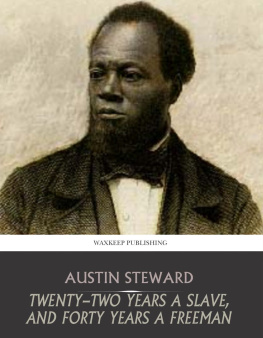About This Edition
This edition is made available under the imprint of DocSouth Books, a collaborative endeavor between the University of North Carolina at Chapel Hill Library and the University of North Carolina Press. Titles in DocSouth Books are drawn from the Librarys Documenting the American South (DocSouth) digital publishing program, online at docsouth.unc.edu. These print and downloadable e-book editions have been prepared from the DocSouth electronic editions.
Both DocSouth and DocSouth Books present the transcribed content of historic books as they were originally published. Grammar, punctuation, spelling, and typographical errors are therefore preserved from the original editions. DocSouth Books are not intended to be facsimile editions, however. Details of typography and page layout in the original works have not been preserved in the transcription.
DocSouth Books editions incorporate two pagination schemas. First, standard page numbers reflecting the pagination of this edition appear at the top of each page for easy reference. Second, page numbers in brackets within the text (e.g., [Page 9]) refer to the pagination of the original publication; online versions of the DocSouth works use this same original pagination. Page numbers shown in tables of contents and book indexes, when present, refer to the original works printed page numbers and therefore correspond to the page numbers in brackets.
Summary
Thomas H. Jones originally published his memoir in order to raise money for his son's freedom. The first edition of his narrative appeared in 1854 or 1855 as an abolitionist pamphlet titled Experience and Personal Narrative of Uncle Tom Jones, Who Was for Forty Years a Slave. After its initial publication, Jones continued to revise and reprint the narrative, and editions appeared in 1855, 1862, 1868, 1871, 1880, and 1885. These publication dates, as well as the publishers that released the editions, remain a major source of critical conversation for Jones scholars. In each edition, Jones further develops the story of his time in slavery and capitalizes on popular abolitionist sympathies, promoting his cause and refining his image as a community and religious leader.
Summaries of the 1850s and 1862 versions are available on the DocSouth website. The edition of Jones's narrative summarized here appeared in 1885. As he did with the 1862 publication, Jones alters the title and frontispiece of his work, hinting at the changing editorial aims of the entire autobiography. The original 1850s title refers to Jones as "Uncle Tom" and features a pipe-smoking caricature and an image of a rustic cabin, tying it to Harriet Beecher Stowe's popular 1852 abolitionist novel, Uncle Tom's Cabin. Subsequent editions provides his full name,Thomas H. Jones,in the title and features a portrait of a well-dressed African American man; the 1885 edition adds the designation of "Reverend." As earlier changes move Jones away from association with a fictional abolitionist character and toward the establishment of a man with developing social authority, the addition of "Reverend" underscores his focus on ministry and his prominence in African American religious communities.
The 1885 edition reprints Jones's expanded 1862 edition of his memoir and includes an addendum that describes his ministry during slavery as well as his experiences as a minister on the abolitionist lecture circuit. Jones uses the new, second part of his narrative to "rehearse a few additional experiences of [his] life while yet a slave" and describe his ministries in North Carolina, the British provinces, Nova Scotia, and Great Britain (p. 45).
Jones provides detailed descriptions of the religious meetings he conducts during his time under slavery near Wilmington, including conversions, baptisms, and encounters with patrols that discourage slave meetings. His owner Jones also notes the intermixing of races at these gatherings. He often comments on the ways in which common religious devotion overcomes racial differences: "Whites prayed for blacks, and blacks for whites. All distinctions as between the different races seemed to have disappeared altogether, and everybody recognized a common bond of interest and endeavor" (p. 58).
The addendum to this final edition of Jones's autobiography complicates perceived relations between free whites and enslaved African Americans in the South by juxtaposing earlier descriptions of the unjust violence of with several sympathetic, and even fond, depictions of individual whites in that slave-holding community and benign social interaction between the races.
Such attention to the kindness of whitesseen also in Elizabeth Keckley's Behind the Scenesis a common feature of the postbellum slave narrative. The fact that this 1885 edition appeared more than twenty years after the 1863 Emancipation Proclamation may explain Jones's license to reveal the complex nature of human relationships by offering sentimental portraits of slaveholders. Jones may also have included these moments to show acts of Christian love, as he often emphasized the ways in which "both whites and blacks... seemed to have an equal interest in the worship of God's house" (p. 57-58).
Jones concludes his 1885 narrative with a list of abolitionist lectures he conducted before Emancipation. He emphasizes the link between his ministry and his support for abolition, noting in a speech that his "purpose [was] to continue my labors in behalf of my brethren and sisters yet in bondage... Everywhere I went I proclaimed my belief that I should some day witness the downfall of slavery" (p. 74). Writing about his experiences after emancipation, Jones reviews a life of hardships and successes and culminating in thanksgiving for the support of friends as well as "He [who has] answered the prayers of his suffering ones" (p. 74).
Works Consulted
Andrews, William L., "Reunion in the Postbellum Slave Narrative: Frederick Douglass and Elizabeth Keckley," Black American Literature Forum 23.1 (1989): 5-16; Davis, David A., Introduction to The Experience of Rev. Thomas H. Jones, in North Carolina Slave Narratives: The Lives of Moses Roper, Lunsford Lane, Moses Grandy, & Thomas H. Jones, edited by William L. Andrews, Chapel Hill, NC: University of North Carolina Press, 2003.
Jenn Williamson
[Cover Image]













